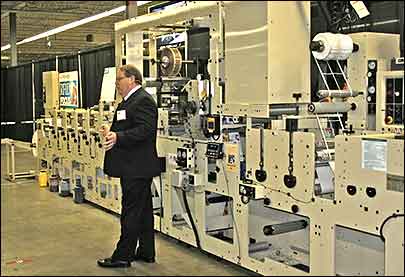May 04, 2005Recent demonstrations by narrow-web printer manufacturer Mark Andyshow that the ability to produce large volumes of RFID labels is close to becoming a reality. Nearly 400 executives, drawn mostly from the label-converting companies, attended the demonstrations at an educational seminar held last week.
Attendees at Mark Andy's "In-Line RFID Solutions for Today's Converters" seminar, held at Mark Andy's Advance Technology and Training Center in Milford, Ohio, on Apr. 27 and 28, saw two live demonstrations of a Mark Andy 2200 narrow-web press-converter producing RFID labels made with Texas Instruments inlays and straps.
In the first demonstration, the Mark Andy 2200 converted inlays into labels. In the second, the Mark Andy 2200 placed RFID straps on printed antennas to create inlays and converted the inlays into labels.
At the end of both demonstrations, one of the finished labels was placed on a package and read as it passed through an RFID portal equipped with SAMSys Technologies' 9310 multiprotocol EPC RFID reader.
According to Mark Andy, the inlay process produced tags at 200 feet per minute, and the strap process worked at 100 feet per minute. While all the products except TI's Gen 2 inlays and straps are commercially available, Mark Andy maintains that its customers will have to wait a few months before they can add an RFID-label manufacturing capability to their machines.
"There is still work to be done on getting the right combination of ink, run speeds and where to put readers. This was just a technology demonstration. It's not 100 percent perfect yet, but it will be within six months," says Ken Daming, director of product management at Mark Andy, which is based in St. Louis.
Both demonstrations used prototype mechanical versions of TI's planned UHF Gen 2 chip and inlay designs and Tamarack Products' commercially available P500 RFID module, which can insert RFID inlays and straps onto labels. To protect RFID circuitry from damaging electrostatic discharge, the Mark Andy 2200 was fitted with static-eliminating equipment from Simco, while the Tamarack P500 RFID inserter module was fitted with antistatic equipment developed by Tamarack and ionization specialist Ion Industrial.
"We want to show how to produce RFID-enabled labels using our existing label machines fitted with an insertion engine. We used the Tamarack module because it is able to insert both lays and straps," Daming says.
A third demonstration showed how RFID antennas could be printed using Mark Andy's Comco ProGlide MSP narrow-web printer and converter using inks from Parelec and ANI Printing Inks. The printed antennas used in the label-making demonstration were made with inks from XINK Laboratories.
"The demonstrations proved that progress has been made in the processes needed to help volume production of RFID tags. Whether showing inlays or straps, the technical demonstrations showed that Mark Andy and its customers take RFID very seriously and are working in innovative and creative ways," says Michael Liard, RFID program director, Venture Development Corp., a Natick, Mass.-provider of market research and consulting services to technology companies who attended the event.
Texas Instruments says it will produce both EPC Gen 2 RFID straps and inlays for placement into labels in volume by the fourth quarter this year. TI will supply reels of straps, which will allow label converters to attach straps directly onto printed antennas, and reels of inlays, which will let label converters insert inlays (chip and antenna) into labels. The company, however, believes that in order produce RFID labels as cheaply as possible, label converters will most likely purchase straps instead of inlays.
"Our vision is that in order to get cost out in the assembly process, savings will have to take place at the inlay level. Going to the strap form factor for label conversion eliminates the need for an inlay form factor," says Bill Allen, director of strategic alliances and programs for Texas Instruments' TI-RFid Systems division, who also attended the event.


